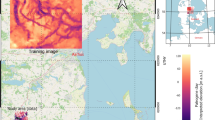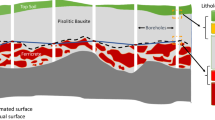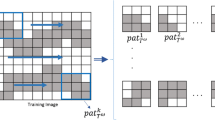Abstract
Stationarity has traditionally been a requirement of geostatistical simulations. A common way to deal with non-stationarity is to divide the system into stationary sub-regions and subsequently merge the realizations for each region. Recently, the so-called partition approach that has the flexibility to model non-stationary systems directly was developed for multiple-point statistics simulation (MPS). The objective of this study is to apply the MPS partition method with conventional borehole logs and high-resolution airborne electromagnetic (AEM) data, for simulation of a real-world non-stationary geological system characterized by a network of connected buried valleys that incise deeply into layered Miocene sediments (case study in Denmark). The results show that, based on fragmented information of the formation boundaries, the MPS partition method is able to simulate a non-stationary system including valley structures embedded in a layered Miocene sequence in a single run. Besides, statistical information retrieved from the AEM data improved the simulation of the geology significantly, especially for the deep-seated buried valley sediments where borehole information is sparse.
Résumé
La stationnarité a toujours été une exigence des simulations géostatistiques. Une façon courante de faire face à la non-stationnarité est de diviser le système en sous-régions stationnaires et ensuit de fusionner les réalisations pour chaque région. Récemment, l’approche dite de partition qui a la flexibilité de modéliser directement des systèmes non stationnaires a été développée pour la simulation de statistiques à multiples points (MPS). L’objectif de cette étude est d’appliquer la méthode de partition MPS aux données de logs de forages conventionnels et aux données électromagnétiques aéroportées de haute résolution (AEM), pour simuler un système géologique réel non stationnaire caractérisé par un réseau de vallées enfouies connectées qui incisent en profondeur les couches sédimentaires du Miocène (cas d’étude au Danemark). Les résultats montrent que, sur la base des informations fragmentées des limites de la formation, la méthode de partition MPS est capable de simuler le système non-stationnaire y compris les structures de vallées enfouies dans la séquence stratigraphique du Miocène en un seul passage. En outre, l’information statistique récupérée à partir des données AEM ont amélioré de manière significative la simulation de la géologie, en particulier pour les sédiments des vallées enfouies en profondeur pour lesquels l’information des forages est clairsemée.
Resumen
La estacionariedad ha sido tradicionalmente un requisito de las simulaciones geoestadísticas. Una forma común de tratar la no estacionariedad es dividir el sistema en sub-regiones estacionarias y subsecuentemente combinar los ensayos para cada región. Recientemente, se desarrolló para la simulación de las estadísticas de puntos múltiples (MPS) el así llamado enfoque de partición que tiene la flexibilidad para modelar directamente sistemas no estacionarios. El objetivo de este estudio es aplicar el método de la partición de MPS con los registros convencionales de pozos y datos electromagnéticos aéreos (AEM) de alta resolución, para la simulación de un sistema geológico no estacionario real caracterizado por una red de valles enterrados conectados que se introducen profundamente en las capas de los sedimentos del Mioceno (caso de estudio en Dinamarca). Los resultados muestran que, sobre la base de información fragmentada de los límites de la formación, el método de partición MPS es capaz de simular un sistema no estacionario, incluyendo estructuras de valles incluidos en una secuencia de capas miocenas en una sola corrida. Además, la información estadística recuperada de los datos de AEM mejoraron la simulación de la importancia de la geología, especialmente para los sedimentos de valles enterrados profundamente asentados donde la información de pozos es escasa.
摘要
平稳性传统上是地质统计学模拟的必要条件。处理非平稳性的常用方法就是把系统划分为平稳的亚区,然后在实现每个区的合并。近来,针对多点统计学模拟,开发了对直接模拟非平稳性系统有灵活性的所谓分割法。研究的目的就是应用多点统计学分割法并结合常规钻孔录井和高分辨率航空电磁资料模拟真实世界非平稳性地质系统,这个系统的特点就是具有连接的埋藏河谷的网络,其河谷深深切割到层状的中新世沉积物中(丹麦的研究案例)。结果显示,根据地层边界的零散信息,多点统计学分割法能够一次模拟非稳定性系统,包括嵌入层状中世纪沉积物中的河谷结构。此外,从航空电磁资料中得到的统计信息大大改进了地质情况模拟的效果,特别是对于钻孔信息匮乏的深层埋藏的河谷沉积物更是如此。
Resumo
Estacionariedade tem sido tradicionalmente uma exigência de simulações geoestatísticas. Uma maneira comum de lidar com não-estacionariedade é dividir o sistema em sub-regiões estacionárias e, posteriormente, mesclar as realizações para cada região. Recentemente, a chamada abordagem de partição, que tem a flexibilidade para modelar sistemas não-estacionários diretamente, foi desenvolvida para simulação estatística multiponto (SMP). O objetivo deste estudo foi aplicar o método de partição SMP com os registros de poços convencionais e dados de alta resolução de levantamento eletromagnético aerotransportado (LEMA), para simulação de um sistema geológico do mundo real não-estacionário caracterizado por uma rede de vales subterrâneos conectados que incidem profundamente em sedimentos em camadas do Mioceno (estudo de caso na Dinamarca). Os resultados mostram que, com base em informações fragmentadas dos limites de formação, o método de partição SMP é capaz de simular um sistema não-estacionário incluindo estruturas de vale incorporados numa sequência em camadas do Mioceno em uma única rodada. Além disso, informações estatísticas obtidas a partir dos dados LEMA melhorou a simulação da geologia significativamente, especialmente para os sedimentos do vale subterrâneo assentados profundamente onde a informação de furos é escassa.









Similar content being viewed by others
References
Alcolea A, Renard P, Mariethoz G, Bertone F (2009) Reducing the impact of a desalination plant using stochastic modeling and optimization techniques. J Hydrol 365:275–288. doi:10.1016/j.jhydrol.2008.11.034
Boucher A (2009) Considering complex training images with search tree partitioning. Comput Geosci 35:1151–1158
Caers J, Avseth P, Mukerji T (2001) Geostatistical integration of rock physics, seismic amplitudes and geological models in North-Sea turbidite systems. Presented at the SPE annual technical conference and exhibition. Society of Petroleum Engineers, New Orleans, LA. doi:10.2118/71321-MS
Chilès JP, Delfiner P (2012) Geostatistics: modeling spatial uncertainty. Wiley, Hoboken, NJ
Carvalho PRM, de Costa JFCL, da Rasera LG, Varella LES (2016) Geostatistical facies simulation with geometric patterns of a petroleum reservoir. Stoch Environ Res Risk Assess 1–18. doi:10.1007/s00477-016-1243-5
Chugunova TL, Hu LY (2008) Multiple-point simulations constrained by continuous auxiliary data. Math Geosci 40:133–146
Comunian A, Renard P, Straubhaar J, Bayer P (2011) Three-dimensional high resolution fluvio-glacial aquifer analog, part 2: geostatistical modeling. J Hydrol 405:10–23
de Vries LM, Carrera J, Falivene O, Gratacós O, Slooten LJ (2009) Application of multiple point geostatistics to non-stationary images. Math Geosci 41:29–42
dell’Arciprete D, Bersezio R, Felletti F, Giudici M, Comunian A, Renard P (2012) Comparison of three geostatistical methods for hydrofacies simulation: a test on alluvial sediments. Hydrogeol J 20:299–311
Deutsch CV, Journel AG (1992) GSLIB geostatistical software library and user’s guide. Oxford University Press, New York
Dickson NEM, Comte J-C, Renard P, Straubhaar JA, McKinley JM, Ofterdinger U (2015) Integrating aerial geophysical data in multiple-point statistics simulations to assist groundwater flow models. Hydrogeol J 23:883–900. doi:10.1007/s10040-015-1258-x
Feyen L, Gorelick SM (2004) Reliable groundwater management in hydroecologically sensitive areas. Water Resour Res 40:W07408. doi:10.1029/2003WR003003
Gómez-Hernández JJ, Wen XH (1998) To be or not to be multi-Gaussian? A reflection on stochastic hydrogeology. Adv Water Resour 21:47–61
Guardiano FB, Srivastava RM (1993) Multivariate geostatistics: beyond bivariate moments. In: Soares A (ed) Geostatistics Tróia ’92, Quantitative Geology and Geostatistics. Springer, Dordrecht, The Netherlands, pp 133–144
GEUS (2013) JUPITER-Denmark’s geological and hydrological database. http://www.geus.dk/DK/data-maps/jupiter/Sider/default.aspx. Accessed February 2013
Harding A, Strebelle S, Levy M, Thorne J, Xie D, Leigh S, Preece R, Scamman R (2005) Reservoir facies modelling: new advances in MPS. In: Leuangthong O, Deutsch CV (eds) Geostatistics Banff 2004, quantitative geology and geostatistics. Springer, Dordrecht, The Netherlands, pp 559–568
He X, Sonnenborg TO, Jørgensen F, Høyer A-S, Møller RR, Jensen KH (2013) Analyzing the effects of geological and parameter uncertainty on prediction of groundwater head and travel time. Hydrol Earth Syst Sci 17:3245–3260. doi:10.5194/hess-17-3245-2013
He XL, Sonnenborg TO, Jørgensen F, Jensen KH (2014) The effect of training image and secondary data integration with multiple-point geostatistics in groundwater modelling. Hydrol Earth Syst Sci 18:2943–2954. doi:10.5194/hess-18-2943-2014
Honarkhah M, Caers J (2012) Direct pattern-based simulation of non-stationary geostatistical models. Math Geosci 44:651–672
Huysmans M, Dassargues A (2009) Application of multiple-point geostatistics on modelling groundwater flow and transport in a cross-bedded aquifer (Belgium). Hydrogeol J 17:1901–1911
Jørgensen F, Sandersen PBE (2006) Buried and open tunnel valleys in Denmark: erosion beneath multiple ice sheets. Quat Sci Rev 25:1339–1363
Jørgensen F, Damgaard J, Olesen H (2008) Impact of geological modelling on groundwater models: a case study from an area with distributed, isolated aquifers. In: Refsgaard JC, Kovar K, Haarder E, Nygaard E (eds) Calibration and reliability in groundwater modelling: credibility of modelling. IAHS Publ. 320, IAHS, Wallingford, UK, pp 337–344
Jørgensen F, Sandersen PBE (2009) Buried valley mapping in Denmark: evaluating mapping method constraints and the importance of data density. Z Dtsch Ges Geowiss 160(3):211–223
Jørgensen F, Høyer A-S, Sandersen PBE, He XL, Foged N (2015) Combining 3D geological modelling techniques to address variations in geology, data type and density: an example from southern Denmark. Comput Geosci 81:53–63. doi:10.1016/j.cageo.2015.04.010
Kellett R, Geoph P (2007) A geophysical facies description of Quaternary channels in northern Alberta. CSEG Recorder 32(10):49–55
Linde N, Lochbühler T, Dogan M, Van Dam RL (2015) Tomogram-based comparison of geostatistical models: application to the macrodispersion experiment (MADE) site. J Hydrol 531(part 3):543–556. doi:10.1016/j.jhydrol.2015.10.073
Liu Y, Harding A, Gilbert R, Journel AG (2005) A workflow for multiple-point geostatistical simulation. In: Leuangthong O, Deutsch CV (eds) Geostatistics Banff 2004, quantitative geology and geostatistics. Springer, Dordrecht, The Netherlands, pp 245–254
Liu Y (2006) Using the SMESIM program for multiple-point statistical simulation. Comput Geosci 32:1544–1563
Maharaja A (2008) TiGenerator: object-based training image generator. Comput Geosci 34:1753–1761
Mariethoz G, Caers J (2015) Multiple-point geostatistics: stochastic modeling with training images. Wiley, Kuala Lumpur, Malaysia
Mariethoz G, Renard P, Straubhaar J (2010) The direct sampling method to perform multiple-point geostatistical simulations. Water Resour Res 46:W11536. doi:10.1029/2008WR007621
Miljøcenter Ringkøbing (2010) Kortlægning af grundvandsressourcen I Tranmose-Brejning kortlægningsområde Redegørelsesrapport [Mapping groundwater in Tranmose-Brejning area. Statement report]. Miljøcenter Ringkøbing, Flemming Sørensen, Denmark
Ogunsuyi FO, Schmitt DR (2010) 22. Integrating Seismic-Velocity Tomograms and Seismic Imaging: application to the Study of a Buried Valley. In: Miller RD, Bradford JH, Holliger K (eds) Advances in near-surface seismology and ground-penetrating radar. Society of Exploration Geophysicists, Tulsa, OK, pp 361–378
Oldenborger GA, Pugin AJ-M, Pullan SE (2013) Airborne time-domain electromagnetics, electrical resistivity and seismic reflection for regional three-dimensional mapping and characterization of the Spiritwood Valley Aquifer, Manitoba, Canada. Near Surface Geophys 11. doi:10.3997/1873-0604.2012023
Rasmussen ES (2004) Stratigraphy and depositional evolution of the uppermost Oligocene-Miocene succession in western Denmark. Bull Geol Soc Denmark 51:89–109
Remy N, Boucher A, Wu J (2011) Applied geostatistics with SGeMS: a user’s guide. Cambridge University Press, Cambridge
Ritzi RW, Jayne DF, Zahradnik AJ, Field AA, Fogg GE (1994) Geostatistical modeling of heterogeneity in glaciofluvial, buried-valley aquifers. Ground Water 32:666–674. doi:10.1111/j.1745-6584.1994.tb00903.x
Scharling PB, Rasmussen ES, Sonnenborg TO, Engesgaard P, Hinsby K (2009) Three-dimensional regional-scale hydrostratigraphic modeling based on sequence stratigraphic methods: a case study of the Miocene succession in Denmark. Hydrogeol J 17:1913–1933
Strebelle S (2002) Conditional simulation of complex geological structures using multiple-point statistics. Math Geol 34:1–21
Strebelle S (2006) Sequential simulation for modeling geological structures from training images. In: Coburn TC, Yarus JM, Chambers RL (eds) Stochastic modeling and geostatistics: principles, methods, and case studies, vol II: AAPG computer applications in geology 5. AAPG, Tulsa, OK, pp 139–149
Strebelle S, Cavelius C (2013) Solving speed and memory issues in multiple-point statistics simulation program SNESIM. Math Geosci 46:171–186. doi:10.1007/s11004-013-9489-7
Sørensen KI, Auken E (2004) SkyTEM: a new high-resolution helicopter transient electromagnetic system. Explor Geophys 35:191–199
Weissmann GS, Fogg GE (1999) Multi-scale alluvial fan heterogeneity modeled with transition probability geostatistics in a sequence stratigraphic framework. J Hydrol 226:48–65
Wu J (2012) Reservoir geobody calculation. USPTO assignment US20120150501 A1, USPTO, Washington, DC
Acknowledgements
The first author acknowledges the HOBE research centre for funding this research. The authors would also like to thank the editor Jean-Michel Lemieux, the associated editor, reviewer Joao Felipe Costa and three other anonymous reviewers for constructive comments.
Author information
Authors and Affiliations
Corresponding author
Rights and permissions
About this article
Cite this article
He, X., Sonnenborg, T.O., Jørgensen, F. et al. Modelling a real-world buried valley system with vertical non-stationarity using multiple-point statistics. Hydrogeol J 25, 359–370 (2017). https://doi.org/10.1007/s10040-016-1486-8
Received:
Accepted:
Published:
Issue Date:
DOI: https://doi.org/10.1007/s10040-016-1486-8




